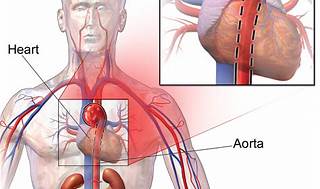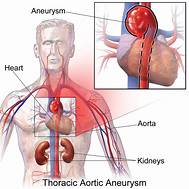A student nurse asks the RN about the clinical manifestations of a thoracic aortic aneurysm. Which of the following findings should the nurse discuss? (Select all that apply).
Shortness of breath
Difficulty swallowing
Upper chest pain
Diaphoresis
Cough
Hoarseness
Correct Answer : A,B,C,E,F
Choice A: Shortness of breath Shortness of breath can occur with a TAA due to the aneurysm compressing the trachea or the lung tissue. As the aneurysm enlarges, it can impinge on respiratory structures, leading to difficulty in breathing. A thoracic aortic aneurysm (TAA) is a bulging or dilation in the wall of the aorta as it passes through the chest cavity. TAAs can be life-threatening if they rupture or dissect and are often difficult to detect because they tend to grow slowly and usually do not cause symptoms until they become large or rupture.
Choice B: Difficulty swallowing Difficulty swallowing, or dysphagia, may be experienced if a TAA exerts pressure on the esophagus. This can happen when the aneurysm is located in the aortic arch, where the esophagus is in close proximity.
Choice C: Upper chest pain Upper chest pain is a common symptom of TAA and may be described as a deep, steady pain that can radiate to the back, neck, or jaw. The pain is caused by the stretching of the aortic wall and may be a warning sign of an impending rupture.
Choice D: Diaphoresis Diaphoresis, or excessive sweating, is not typically a direct symptom of a TAA. However, it can be associated with acute aortic syndromes, such as aortic dissection or rupture, which are medical emergencies.
Choice E: Cough A persistent cough can be a sign of a TAA, especially if the aneurysm is pressing against the trachea or bronchial tubes. The cough may sometimes produce blood if the aneurysm is causing erosion into these structures.
Choice F: Hoarseness Hoarseness can result from a TAA if the aneurysm compresses the recurrent laryngeal nerve, which controls the muscles of the voice box. This is known as Ortner’s syndrome or cardiovocal syndrome.


Nursing Test Bank
Naxlex Comprehensive Predictor Exams
Related Questions
Correct Answer is B
Explanation
Choice A reason:Bubbling in the water seal chamber with exhalation can be normal, indicating that air is being evacuated from the pleural space.
Choice B reason:Crepitus, or subcutaneous emphysema, can indicate that air is leaking into the tissue around the chest tube site, which is a serious complication that requires immediate attention.
Choice C reason:
Movement of the trachea toward the unaffected side can indicate tension pneumothorax, a life-threatening condition that also requires immediate attention.
Choice D reason:If the eyelets of the chest tube are not visible, it may simply mean that the tube is inserted fully, which is not an immediate cause for concern unless other symptoms are present.
Correct Answer is C
Explanation
Choice A reason: Bradycardia, which is a slower than normal heart rate, is not a common finding associated with renal calculi. Renal calculi, or kidney stones, typically cause symptoms related to the urinary system rather than directly affecting the heart rate.
Choice B reason: Bradypnea, or abnormally slow breathing, is also not a typical symptom of renal calculi. Patients with kidney stones may experience changes in urination patterns, such as frequency or urgency, but not typically changes in respiratory rate.
Choice C reason: Severe pain is indeed the most common symptom associated with renal calculi. This pain, known as renal colic, is often sudden in onset, very severe, and may radiate from the back down to the lower abdomen or groin. The pain is caused by the stone moving into the ureter and causing a blockage, which leads to increased pressure and stretching of the kidney or ureter. Renal calculi can cause a range of symptoms, with severe pain being the most prominent and often the first symptom that leads individuals to seek medical care. The pain is typically very intense and can be accompanied by other symptoms such as nausea, vomiting, and hematuria (blood in the urine).
Choice D reason: Nocturia, or frequent urination at night, can be a symptom of renal calculi, especially if the stones affect the bladder or cause urinary tract infections. However, the most characteristic symptom of renal calculi is severe pain, not necessarily nocturia.
Whether you are a student looking to ace your exams or a practicing nurse seeking to enhance your expertise , our nursing education contents will empower you with the confidence and competence to make a difference in the lives of patients and become a respected leader in the healthcare field.
Visit Naxlex, invest in your future and unlock endless possibilities with our unparalleled nursing education contents today
Report Wrong Answer on the Current Question
Do you disagree with the answer? If yes, what is your expected answer? Explain.
Kindly be descriptive with the issue you are facing.
